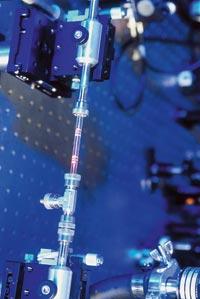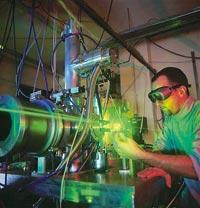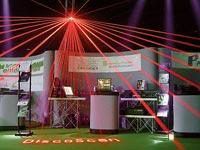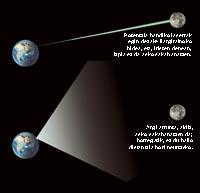 The laser has changed the world. It is only light, but the world has changed. Seven decades ago it could not be guessed that man healed with light some diseases. Or build their houses. Or use it to cut, measure, read, write. A simple light, I would say. However, the laser is not a simple light, but the elaborate result of a complex technology. The flute would not have made man a laser before developing quantum theory. And when he developed it it wasn't easy either. From the present point of view, it seems a lie. The laser is at the core of our technology. Both research and everyday use. Take a look at the area and find it wherever you want: CDs readers, barcodes, printers, etc. in thousands of sites. What does that light have for so many things? Amplified light The truth is that the question is not what the laser has, but how it is done. Physicists say that the laser is an amplified, single-colored, coherent light. A light that doesn't have all that is not laser. Its name indicates: laser. This word is acronym and comes from the English Light Amplification by Stimulated Emission of Radiation. Light amplification by emission of stimulated radiation.  The laser is a concentrated light. Therefore, it can cause eye damage.
Therefore, to work with laser it is necessary to protect the eyes. Being an amplified light, the heart of the laser is an amplifying material. In short, this material absorbs and releases the energy given to it, but it releases it clearly. That is, it turns energy into light. Regardless of whether the amplifier is solid, liquid or gas, it must perform such transformation. There are many amplifying substances. The first they used was ammonia gas. As for solids, ruby has been widely used as it gives red laser. However, many other substances have been used depending on the type of laser. Most existing lasers on the market today use a material called 'Nd:YAG', a solid composed of mineral garnet and itrium element, with a few neodymium atoms interspersed.  Of course, laser has become the symbol
of modern aesthetics in recent years. Of course, you have to power the amplifier. Therefore, the basic component of a laser is the energy source. This source can be an electric current or a high-intensity light in the case of solid lasers. In the beginning this light was provided by a tube full of xenon atoms, which acted as a photographic flash, but today a laser diode is used. Yes, the energy source of a laser can be another laser! Between mirrors Perhaps the most surprising part of the laser design is both the simplest: light is trapped between two mirrors. The trapped light circulates through the mirrors and crosses the amplifier on each path. Thanks to a quantum effect, this light also becomes a source of energy, each photon produces the emission of another each time it hits the amplifier. Do you remember? The term "stimulated emission" appears in the name of Laser and corresponds to this quantum effect. Therefore, the light itself helps to amplify, then it is reflected in a mirror and the process is restarted. Thus, the light of a laser is greatly amplified. That's why they call the laser oscillator. But, of course, you have to somehow cut the movements between mirrors. The ray of light must come out. This is because the two mirrors are not the same. One reflects all the light that comes to him and the other only one part. The first is a full reflector and the second partial. Depending on the type of laser, more or less light escapes between the two mirrors and that beam that comes out is the laser beam.  The laser
is used, among other things, to read CDs. In addition to amplifying the light, the dance between two mirrors has other advantages. On the one hand, the ray is little scattered. You get a very narrow beam, as only the waves that go from the mirror to the mirror come out. That is why it is possible to concentrate the light of a laser at one point. This allows the laser to heat a small area, like when we concentrate sunlight with a magnifying glass. On the other hand, with this system you get a light of a frequency, that is, a single color. The light produced by each amplifier is one color, but the technology is never perfect. The light produced is not of a single color, but a combination of many very similar rays, whose spectrum is very narrow but not of a frequency. Well, the partial reflector helps to further narrow this generated frequency range. There are rays that do not let pass, so the spectrum that comes out is even narrower than that produced inside. Experts say that this mirror increases the purity of the color of lasers. Admirable light Intense light, monocolor and narrow beam, the laser is not a normal light. Being very concentrated, it also has the ability to cut metals. And, despite the great distance, it only generates a point of light. The truth is that this is not entirely correct, like any other light, the laser beam scatters, but it has to travel a long distance until it expands. An example is the distance to the Moon, located about 384,000 kilometers. Not all lasers have enough power to get there, but the rays of those who arrive are not totally scattered at that distance. In
many lasers used as slide displays and the like, for example, the beam expands 1.2 millimeters per meter forward (dispersion level advertised by vendors). This means that illuminating the Moon from Earth, the ray would have a diameter of 460.8 kilometers. Many other lasers are more precise, as the ray of those used to measure the distance to the Moon is about 5 kilometers wide on the surface of the Moon. It may seem that a very wide beam arrives, but depending on the distance it can be considered as a narrow beam. There is no other light that reaches so scattered to the Moon. However, do not try to illuminate the Moon with any laser you have at home. Lightning will not come, it is a power problem. In most applications the laser beam does not travel this distance, so it is useless to use high-power lasers in homes. Everything in its measure. Stimulated radiation emission The light of a laser is amplified by electrons. Electrons easily absorb and release energy, as well as allow exhaustive control of these removals and detachments. We must think that the nuclei of atoms move according to the energy that electrons have. By absorbing energy they pass to a higher level. And when they return to the lower level they release the amount of energy between the two levels. In lasers, electrons of the amplifying substance release energy in the form of light. But this effect is not enough to amplify the light. An electron at a higher level normally falls spontaneously to the lower level if that level is empty. But if you absorb a photon before this happens, it falls to the lower level and emits two photons, twice what it
normally emits. This is the stimulated emission; the electron is stimulated by a photon that emits two photons instead of one. The two photons that are generated are in phase, that is, they do not interfere with each other. According to physicists, the light produced by these waves is 'coherent'.  However, electrons last very little time at the higher energy levels, fall quickly by themselves and the stimulation time is very low. Under normal conditions, most electrons of a substance are at the lower levels. Therefore, for the manufacture of lasers it is necessary to look for substances that contain electrons at higher levels for a long time.
Blonde was one of the first. In this jewel, electrons have more than three energy levels. Therefore, if an electron jumps to the highest level, it has the possibility of descending gradually and has time until it returns down to have a stimulated emission. In addition, the photon emitted by an electron from an atom can stimulate another electron from the adjacent atom. This causes a chain reaction in the neighboring atoms. Thus, light is greatly amplified. | |